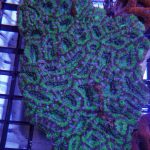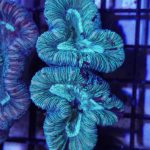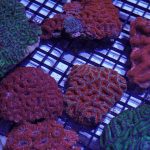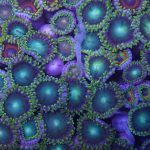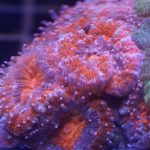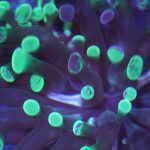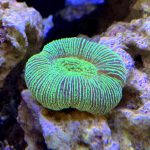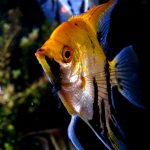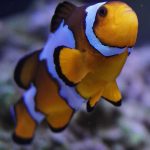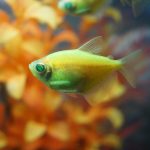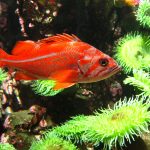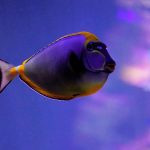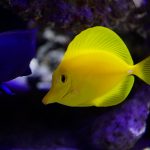Large polyp stony, or SPS corals, includes a vast range of coral species and genera that defy easy categorization. SPS coral polyps vary in size from just a few millimeters across to several centimeters or more across and most coral reefs around the world have populations of SPS and LPS corals living more or less side by side in less-than-peaceful competition for light, living space and resources. Most LPS species are capable of sending out mesentery filaments, or sweeper tentacles, which will attack and digest the tissue of other corals encroaching on their living space. It is not uncommon for more aggressive corals to sting their neighbors. If preventative measures are not taken by providing a bit more space between them, many corals will sting a neighbor to death, consume the tissue and leave an empty skeleton.
Another characteristic that LPS corals all share is a larger, fleshy polyp capable of producing its own calcareous skeleton. Another is that they tend to be zooxanthellate, or host symbiotic photosynthetic algae call zooxanthellae in their tissue. The host coral benefits from the glucose and nutrients produced as byproducts of photosynthesis and the algae are (mostly) safe from the many grazers that keep algae from outcompeting corals for space and sunlight on the world’s reefs.
Common LPS Species
Some of the most common LPS genera found in local and online retailers include:
- Alveopora spp.
- Euphyllia spp.
- Acanthastrea spp.
- Acanthophyllia spp.
- Caulastrea spp.
- Echinophyllia spp.
- Favia spp.
- Blastomussa spp.
- Cynarina spp.
- Fungia spp.
- Goniopora spp.
- Galaxea spp.
- Scolymia spp.
- Lobophyllia spp.
- Many, many other genera in a near-endless variety of polyp shapes and colors
Lighting Requirements
Generally, LPS corals tend to prefer medium to low light and placement on the substrate or middle part of the water column. As a rule, it is best to place a new LPS coral in your collection in a spot lower than your intended location to ensure that the zooxanthellae do not become shocked and die from lighting that is too intense and/or a photoperiod that is too long. When the zooxanthellate algae get shocked, they become stressed and often lose much of their color. When this happens, this may or may not mean the coral is doomed. If you believe that you have shocked your coral, move it to a somewhat sheltered location and monitor it closely to determine how or if it is responding or fading away. If the polyps start to brown, carefully expose the colony to a bit more light; if the color starts to become less uniform or show less variety of color, it’s is probably getting too much light.
Also look closely at the posture and turgidity, or swollenness, of the polyps. If the polyp(s) is full and lush appearing, there is a chance that the algae and the host coral can recover. If the polyp is droopy and the flesh is retracting from the margins of its skeleton, that coral is quite stressed and while it may not be dying, it is probably heading in that direction and will require extra care to prevent it from continuing to retract. One of the most challenging aspects of coral husbandry is having the patience to see the effect that altering lighting, flow, placement, and other considerations have on your corals. If you have a stressed coral, give it at least two weeks and preferably more time to recover before trying anything else. Only then will you be able to determine whether or not this was the right decision. Having this kind of patience is not easy but it is immensely useful an essential for becoming a more confident, knowledgeable and accomplished coralhead.
Water Flow Requirements
As usual, when it comes to corals of any kind, the amount of flow required to keep a colony or polyp happy and healthy is very much specific to each species. Note that we said “species” and not “genus,” as some LPS genera contain a seemingly improbable range of polyp types and sizes that vary widely from one species to the next. That said, LPS corals generally prefer medium to low water flow and many will not tolerate flow that is too aggressive. To determine the flow requirements of each species, look for polyp extension, turgidity, the polyp’s posture on the skeleton, etc. If the polyp is pulling away from the margins of its skeleton, it is probably being buffeted about more than its liking and will continue to retract to prevent further damage.
If a LPS coral becomes stressed from improper flow, use the same approach and patience that you would take to save a light-stressed coral: move it to a sheltered area with less direct flow and observe it over time. If you begin to see signs of recovery, wait a few weeks until you’re certain that it needs more flow before you move it. You may have moved it to the perfect spot. Only after careful, patient observation will you know for sure.
Feeding
Most LPS corals benefit from supplemental feeding, as long as it is appropriate for the size of each feeding polyp and is not being force-fed too much for it to digest. Bear in mind that it is very easy to overfeed and stress your corals: it’s a lot of fun to watch your coral polyps open and extend their feeding tentacles to take in food but you can also love them to death. Consider the size of food particles borne on the current to corals on the reefs around the world. Most are tiny bits of plankton, which are easy for polyp tentacles to catch, ingest, digest and export as waste. If you place too large of a piece of food on the coral, it may be able to ingest most or all of the food but too much of a good thing can become a powerful stressor. (Consider how you feel after eating an extra helping of something. It tasted great at the time but a couple hours later you’re regretting that decision.)
Bear in mind that most LPS species feed at night when plankton is more abundant but you can also feed when the lights are on with a little prep work. To induce a feeding response in LPS corals, try shutting off your powerheads and squirting a small amount of mysis juice or something similar at the coral polyps with a pipette a few minutes before feeding. For larger LPS species, such as Trachyphyllia, Scolymia, Acanthophyllia, and others, the center of the oral disk will dilate, allowing the feeding tentacles to deploy and accept food. After you place the food, the coral will slowly ingest it but be watchful, as the fish and inverts in your display quickly learn when it’s feeding time for corals and will steal the food before the polyp gets a chance to ingest it!
Water Quality
LPS corals tend not to require the near-pristine water quality that SPS corals do but you’ll have better results if you strive for and proactively manage water quality to achieve these parameters:
- Ammonia – 0
- Nitrite – 0
- Nitrate – As close to 0 as possible.
- Calcium – 375-450 parts per million (ppm)
- Magnesium – 1300-1350ppm
- Carbonate hardness – > 125ppm (Many reefkeepers use alkalinity and carbonate hardness interchangeably but they are different values)
- Salinity – 35ppt (parts per thousand) or 1.026 specific gravity
- Phosphates – As close to 0 as possible
- pH – 8.1-8.3
- Temperature – 78-82F
Professional Coral reef Aquarium Service in the Portland Area
Many but not all LPS corals tend to be hardy beginner corals if you place them in a well-established tank with reasonably good water quality. If you would like to add a stunning coral display with LPS and SPS corals to your home or office and are looking for a PDX aquarium service professional to build and/or maintain it for you, call us today at (503) 784-4403 or contact us here. These systems tend to require more time, life support equipment and expertise to keep them healthy and vibrant but our clients with coral tanks love the way we keep their coral reef displays looking great!
